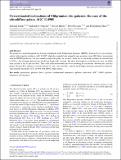Overestimated inclinations of Milgromian disc galaxies : the case of the ultradiffuse galaxy AGC 114905
Abstract
We present hydrodynamical star-forming simulations in the Milgromian dynamics (MOND) framework of a gas-rich disc galaxy with properties similar to AGC 114905, which has recently been argued to have a rotation curve (RC) that is inconsistent with the MOND prediction. Our first model considers the galaxy in isolation, while our second model includes an external field of 0.05a0, the estimated gravitational field from large-scale structure. We show that isophotes in the face-on view can differ from circular at the 50% level. This could mislead observers into overestimating the inclination i between disc and sky planes. Because RCs require a correction factor of 1/sin i, the actual RC could be much higher than reported by observers. This plausibly reconciles AGC 114905 with MOND expectations.
Citation
Banik , I , Nagesh , S T , Haghi , H , Kroupa , P & Zhao , H 2022 , ' Overestimated inclinations of Milgromian disc galaxies : the case of the ultradiffuse galaxy AGC 114905 ' , Monthly Notices of the Royal Astronomical Society , vol. 513 , no. 3 , stac1073 , pp. 3541–3548 . https://doi.org/10.1093/mnras/stac1073
Publication
Monthly Notices of the Royal Astronomical Society
Status
Peer reviewed
ISSN
0035-8711Type
Journal article
Description
Funding: IB is supported by Science and Technology Facilities Council grant ST/V000861/1, which also partially supports HZ.Collections
Items in the St Andrews Research Repository are protected by copyright, with all rights reserved, unless otherwise indicated.
Related items
Showing items related by title, author, creator and subject.
-
SDSS-IV MaNGA: How the stellar populations of passive central galaxies depend on stellar and halo mass
Oyarzún, Grecco A.; Bundy, Kevin; Westfall, Kyle B.; Tinker, Jeremy L.; Belfiore, Francesco; Argudo-Fernández, Maria; Zheng, Zheng; Conroy, Charlie; Masters, Karen L.; Wake, David; Law, David R.; McDermid, Richard M.; Aragón-Salamanca, Alfonso; Parikh, Taniya; Yan, Renbin; Bershady, Matthew; Sánchez, Sebastián F.; Andrews, Brett H.; Fernández-Trincado, José G.; Lane, Richard R.; Bizyaev, D.; Boardman, Nicholas Fraser; Lacerna, Ivan; Brownstein, J. R.; Drory, Niv; Zhang, Kai (2022-07-06) - Journal articleWe analyze spatially resolved and co-added SDSS-IV MaNGA spectra with signal-to-noise ratio ∼100 from 2200 passive central galaxies (z ∼ 0.05) to understand how central galaxy assembly depends on stellar mass (M*) and halo ... -
Secular-and merger-built bulges in barred galaxies
Mendez Abreu, Jairo; Debattista, V. P.; Corsini, E. M.; Aguerri, J. A. L. (2014-12) - Journal articleContext. Historically, galaxy bulges were thought to be single-component objects at the center of galaxies. However, this picture is now questioned since different bulge types with different formation paths, namely classical ... -
Galaxy And Mass Assembly (GAMA) : galaxy close pairs, mergers and the future fate of stellar mass
Robotham, A. S. G.; Driver, S. P.; Davies, L. J. M.; Hopkins, A. M.; Baldry, I. K.; Agius, N. K.; Bauer, A. E.; Bland-Hawthorn, J.; Brough, S.; Brown, M. J. I.; Cluver, M.; De Propris, R.; Drinkwater, M. J.; Holwerda, B. W.; Kelvin, L. S.; Lara-Lopez, M. A.; Liske, J.; Lopez-Sanchez, A. R.; Loveday, J.; Mahajan, S.; McNaught-Roberts, T.; Moffett, A.; Norberg, P.; Obreschkow, D.; Owers, M. S.; Penny, S. J.; Pimbblet, K.; Prescott, M.; Taylor, E. N.; van Kampen, E.; Wilkins, S. M. (2014-11-11) - Journal articleWe use a highly complete subset of the Galaxy And Mass Assembly II (GAMA-II) redshift sample to fully describe the stellar mass dependence of close pairs and mergers between 10(8) and 10(12)M(circle dot). Using the analytic ...

